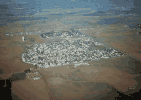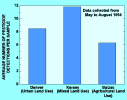Mixed (urban/agriculture) land use has developed along the Front Range urban corridor starting just north of Denver, Colo., and extending to the Fort Collins, Colo., area. Water quality in this mixed land-use setting is the product of combined urban and agricultural land-use practices. For example, nitrate in surface water can be attributed in part to the large number of permitted discharges of WWTP effluent (point sources) in the urban area. However, ground-water irrigation return flows (nonpoint sources) from agricultural lands also contribute to the nitrate load in the river (McMahon and Böhlke, 1996).
 (31,089 bytes)
(31,089 bytes)
An example of a mixed (urban/agriculture) land-use setting, Dacono, Colo.
The average number of pesticides detected in surface-water samples at main-stem synoptic sites was greater in mixed land-use areas than in land-use settings that were exclusively urban or agricultural. The types of pesticides detected were a combination of the types of pesticides generally associated with urban settings (prometon, simazine, carbaryl, and diazinon) and those used commonly in agricultural areas (atrazine, metolachlor, cyanazine, and EPTC) (Kimbrough and Litke, in press). Pesticide concentrations measured at mixed land-use sites did exceed aquatic life criteria for three pesticides (Gilliom and others, in press); however, no drinking-water criteria were exceeded. Although no pesticides exceeded MCLs, the ecological or human health effects of long-term exposure to low concentrations of multiple pesticides is unknown.
 (7,937 bytes)
(7,937 bytes)
More pesticides were detected in surface-water samples from mixed (urban/agriculture) land-use areas.
The organochlorine compounds DDT, chlordane, dacthal, dieldrin, and PCB in bed sediment and fish tissue were detected in the greatest number and at the highest concentrations in streams affected by urban and mixed land use (see Summary of Compound Detections and Concentrations section, p. 28-34 for range of concentrations). This result represents a cumulative effect of multiple land uses (urban/agriculture) (Tate and Heiny, 1996). Furthermore, the highest mean concentrations of federally banned compounds (DDT and its metabolites, dieldrin, and total PCBs) in bed sediment and fish tissue throughout the basin occurred in the mixed land-use setting. Although these compounds have been restricted or banned for 20 to 25 years, they still are present in the environment and in a few samples persist at concentrations above levels of concern for the protection of fish-eating wildlife (Tate and Heiny, 1996).
Streams in the mixed land-use setting are slow moving with meandering to straight channels composed of runs and point bars. Channel bottoms are composed of gravel, the canopy is open with some overhanging vegetation, and streambanks are eroding or lined with rip-rap. Bank erosion and vegetation instability, which result in increased suspended sediment and less favorable habitat conditions for biological communities, are common in mixed land-use streams. The cumulative effect of contaminants from point and nonpoint sources and habitat alterations generally decreased the number of insect (invertebrate) species (Tate and Heiny, 1995) and also resulted in fish populations representative of moderately to significantly affected water-quality conditions based on an IBI.
The cumulative effects on water quality from urban and agricultural land uses in the mixed land-use setting were greater for selected constituents than in either land use alone. |